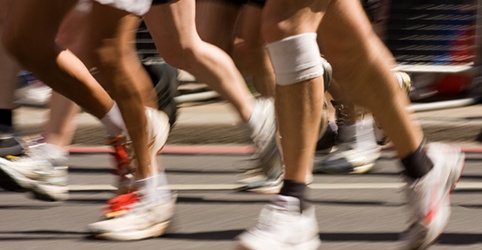
The knee is a highly technical and crucial part of your body composed of many bones, tendons, ligaments, cartilage, muscles, and fluid. An injury to any part of the knee for an athlete can become detrimental to their season and possibly their overall athletic career. Usually when someone hears about a knee injury, their initial thought is a ligament or meniscus tear which is true in contact sports like football and rugby, or sports that constantly require the athlete to quickly change direction such as tennis or basketball.
For a runner, tears don’t commonly come around; it’s possible but not as common as patellofemoral pain syndrome also conveniently known as ‘runner’s knee’.
In order to minimize the risk of injuries it is important to have the ability to diagnose a problem and treat it. Personally I have never experienced runners knee but have felt the aches and pains in my knees an athlete gets throughout their years and those in themselves can make you second guess why you do these activities. Some people follow the mantra of “no pain, no gain”. The point I’m making about these runners is they have pain in their knee or knees and think it’s something minor that doesn’t need attended to. By ignoring what your body is saying, sometimes screaming to you, can lead to worse problems and even serious injuries.
Runners knee isn’t an issue experienced in an instantaneous moment like a knee injury such as an ACL tear, but rather a gradual pain felt under the kneecap and anywhere around it. Feeling pain when you bend the knee while walking or running with an increase of pain as you run downhill or downstairs are signs of runners knee. Ilitobial Band Syndrome or IT Band Syndrome is often confused for runners knee due to a sharp pain on the side of the knee on your lateral epicondyle. This article is helpful for determining the difference between runners knee and IT Band Syndrome.

If you’ve read previous blog posts on Sensoria’s website then the information on how bad heel striking is for your body has been pounded into your head with a greater force than the pounding your body takes while heel striking. You stop heel striking and keep a higher cadence; you reduce impact forces and your chances of being injured will probably decrease. Downhill running can lead to runners knee because while downhill running you are putting all your weight on an extended leg over and over again. On top of that for some people over striding may also add to this issue.
Also, while you downhill run you are producing a concentric contraction (shortening) of the hamstring muscles and an eccentric (lengthening) of the quadriceps. The quads are responsible for stabilizing the knee, but while they are relaxed for a long period of time the hamstrings will be doing most of the work causing the knee to move. Uphill training is great for conditioning and also for reducing risk of injuries since it is almost impossible to pull a muscle or hurt your knees while uphill running.
With the knee being so technical and crucial to running, it is key take care of all the bones, muscles, tendons, ligaments, and cartilage. Between 20-25% of runners will get runners knee which at first may be mild but can turn into excruciating pain over time and slow down your running goals. Stay in the game and on the track with proper training, technique, and knowledge about injuries and always listen to your body and how it reacts to certain environments and situations.
References:
– Running Competitor – Beating Runners Knee
– WebMD – Runner Knee
